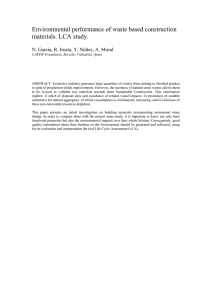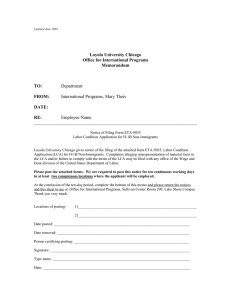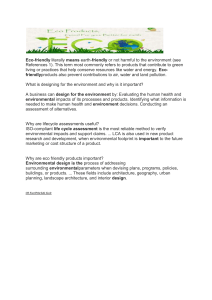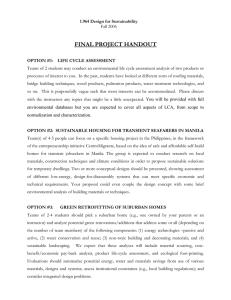Estimates of combining ability for biochemical traits in chilli
advertisement
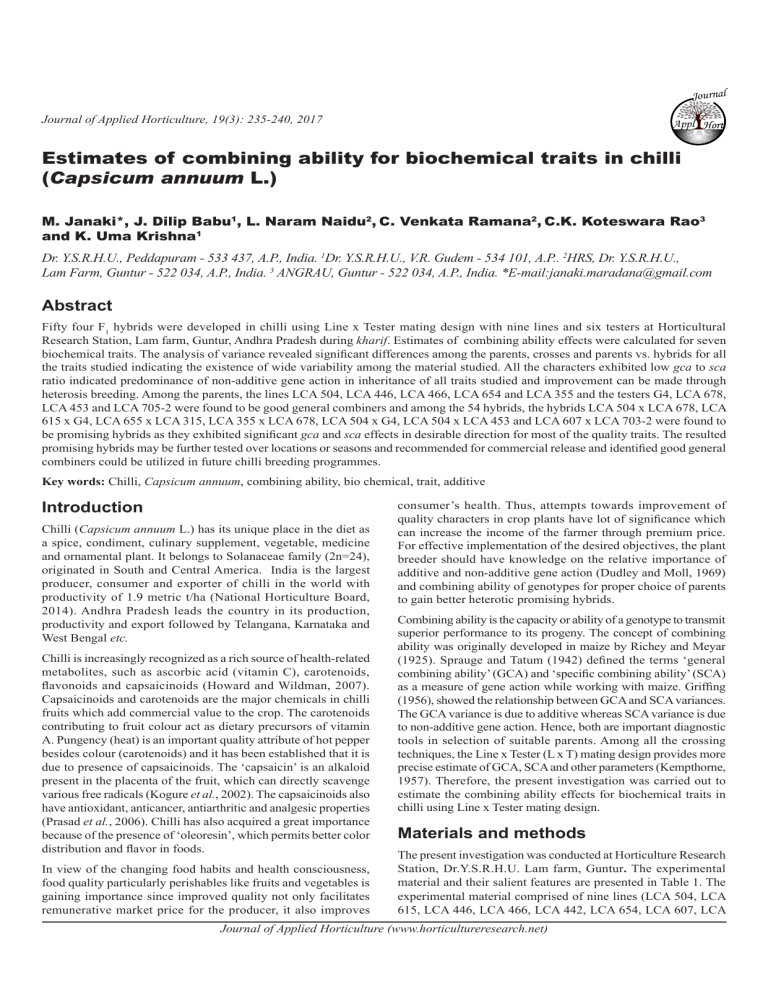
Journal Journal of Applied Horticulture, 19(3): 235-240, 2017 Appl Estimates of combining ability for biochemical traits in chilli (Capsicum annuum L.) M. Janaki*, J. Dilip Babu1, L. Naram Naidu2, C. Venkata Ramana2, C.K. Koteswara Rao3 and K. Uma Krishna1 Dr. Y.S.R.H.U., Peddapuram - 533 437, A.P., India. 1Dr. Y.S.R.H.U., V.R. Gudem - 534 101, A.P.. 2HRS, Dr. Y.S.R.H.U., Lam Farm, Guntur - 522 034, A.P., India. 3 ANGRAU, Guntur - 522 034, A.P., India. *E-mail:janaki.maradana@gmail.com Abstract Fifty four F1 hybrids were developed in chilli using Line x Tester mating design with nine lines and six testers at Horticultural Research Station, Lam farm, Guntur, Andhra Pradesh during kharif. Estimates of combining ability effects were calculated for seven biochemical traits. The analysis of variance revealed significant differences among the parents, crosses and parents vs. hybrids for all the traits studied indicating the existence of wide variability among the material studied. All the characters exhibited low gca to sca ratio indicated predominance of non-additive gene action in inheritance of all traits studied and improvement can be made through heterosis breeding. Among the parents, the lines LCA 504, LCA 446, LCA 466, LCA 654 and LCA 355 and the testers G4, LCA 678, LCA 453 and LCA 705-2 were found to be good general combiners and among the 54 hybrids, the hybrids LCA 504 x LCA 678, LCA 615 x G4, LCA 655 x LCA 315, LCA 355 x LCA 678, LCA 504 x G4, LCA 504 x LCA 453 and LCA 607 x LCA 703-2 were found to be promising hybrids as they exhibited significant gca and sca effects in desirable direction for most of the quality traits. The resulted promising hybrids may be further tested over locations or seasons and recommended for commercial release and identified good general combiners could be utilized in future chilli breeding programmes. Key words: Chilli, Capsicum annuum, combining ability, bio chemical, trait, additive Introduction Chilli (Capsicum annuum L.) has its unique place in the diet as a spice, condiment, culinary supplement, vegetable, medicine and ornamental plant. It belongs to Solanaceae family (2n=24), originated in South and Central America. India is the largest producer, consumer and exporter of chilli in the world with productivity of 1.9 metric t/ha (National Horticulture Board, 2014). Andhra Pradesh leads the country in its production, productivity and export followed by Telangana, Karnataka and West Bengal etc. Chilli is increasingly recognized as a rich source of health-related metabolites, such as ascorbic acid (vitamin C), carotenoids, flavonoids and capsaicinoids (Howard and Wildman, 2007). Capsaicinoids and carotenoids are the major chemicals in chilli fruits which add commercial value to the crop. The carotenoids contributing to fruit colour act as dietary precursors of vitamin A. Pungency (heat) is an important quality attribute of hot pepper besides colour (carotenoids) and it has been established that it is due to presence of capsaicinoids. The ‘capsaicin’ is an alkaloid present in the placenta of the fruit, which can directly scavenge various free radicals (Kogure et al., 2002). The capsaicinoids also have antioxidant, anticancer, antiarthritic and analgesic properties (Prasad et al., 2006). Chilli has also acquired a great importance because of the presence of ‘oleoresin’, which permits better color distribution and flavor in foods. In view of the changing food habits and health consciousness, food quality particularly perishables like fruits and vegetables is gaining importance since improved quality not only facilitates remunerative market price for the producer, it also improves consumer’s health. Thus, attempts towards improvement of quality characters in crop plants have lot of significance which can increase the income of the farmer through premium price. For effective implementation of the desired objectives, the plant breeder should have knowledge on the relative importance of additive and non-additive gene action (Dudley and Moll, 1969) and combining ability of genotypes for proper choice of parents to gain better heterotic promising hybrids. Combining ability is the capacity or ability of a genotype to transmit superior performance to its progeny. The concept of combining ability was originally developed in maize by Richey and Meyar (1925). Sprauge and Tatum (1942) defined the terms ‘general combining ability’ (GCA) and ‘specific combining ability’ (SCA) as a measure of gene action while working with maize. Griffing (1956), showed the relationship between GCA and SCA variances. The GCA variance is due to additive whereas SCA variance is due to non-additive gene action. Hence, both are important diagnostic tools in selection of suitable parents. Among all the crossing techniques, the Line x Tester (L x T) mating design provides more precise estimate of GCA, SCA and other parameters (Kempthorne, 1957). Therefore, the present investigation was carried out to estimate the combining ability effects for biochemical traits in chilli using Line x Tester mating design. Materials and methods The present investigation was conducted at Horticulture Research Station, Dr.Y.S.R.H.U. Lam farm, Guntur. The experimental material and their salient features are presented in Table 1. The experimental material comprised of nine lines (LCA 504, LCA 615, LCA 446, LCA 466, LCA 442, LCA 654, LCA 607, LCA Journal of Applied Horticulture (www.horticultureresearch.net) 236 Estimates of combining ability for biochemical traits in chilli (Capsicum annuum L.) capsaicin (%), red carotenoids (%), yellow carotenoids (%), total carotenoids (%) and total color value (ASTA units). Table 1. Salient features of parents used in Line x Tester analysis of chilli S.No Parents Lines 1 LCA-504 2 LCA-615 3 LCA-446 4 LCA-466 5 LCA-442 6 LCA-654 7 LCA-607 8 LCA-655 9 LCA-355 Testers 1 G4 2 LCA-678 3 LCA-453 4 LCA-703-2 5 LCA-705-2 6 LCA-315 Checks 1 Indam-5 2 Tejaswini Features The red ripe fruits were sun dried and ground in an electronic grinder and passed through a 0.5 mm sieve and the dry chilli powder was used to measure biochemical constituents whereas mature green fruits were used for estimating the Vitamin ‘C’ content. Ascorbic acid content of mature green fruits was estimated by volumetric (2, 6- dichlorophenol indophenol dye) method described by Sadasivam and Balasubramanian (1987). The oleoresin content was estimated as per the procedure described by Ranganna (1986). The capsaicin content was estimated by colorimetric method described by Balasubramaniam et al. (1982). Total red (CR; capsanthin, capsorubin and capsanthin-5, 6-epoxide) and yellow (C Y; zeaxanthin, violaxanthin, antheraxanthin, â-cryptoxanthin, â-carotene and cucurbitaxanthin A) carotenoid isochromic fractions were estimated following the protocol of spectrophotometric method (Hornero-Mendez and MinguezMosquera, 2001). Total colour value (ASTA- American Spice Trade Association units) was estimated as per the procedure given by Rosebrook et al. (1968). The collected data were analyzed for combining ability according to the standard procedure given by Kempthorne (1957). Drought resistant, highly pungent High yielding line with parrot green fruits Bold pod, high colour and oleoresin Bold and long pod, high colour and oleoresin Bold and long pod, high colour and mild pungent Medium bold, shiny fruit, light green in colour Light green pod, profuse branching Dual purpose variety, bold light green pod High colour with wrinkled surface Dark green (olive green) fruits, virus resistant More primary branches, semi erect plant habit Bold pod, erect growth habit Virus resistant, dark green fruits More no. of fruits, shiny dry pod Virus resistant, fruits are long and dark green Indo-American Hybrid Seeds (India) Pvt.Ltd. Maharashta Hybrid Seeds Co.Ltd. Results and discussion 655 and LCA 355) and six testers (G4, LCA 678, LCA 453, LCA 703-2, LCA 705-2 and LCA 315). These parents were crossed in Line x Tester fashion during Kharif, 2013-14 and 54 F1 hybrids were generated. The resulting 54 F1 hybrids along with their 15 parents and 2 commercial checks (Tejaswini and Indam-5) were evaluated during Kharif, 2014-15 in a Randomized Block Design with three replications. Each genotype was sown in two rows (one row of 4 m length) at spacing of 75 cm x 30 cm. The crop was raised as per the recommended package of practices. Each row consisted of 12 plants, of which five competitive plants were selected at random for collecting the fruit samples to estimate qualitative traits viz. ascorbic acid (mg/100g), oleoresin (%), The analysis of variance (Table 2) revealed significant differences among the parents, crosses and parents vs. hybrids for all the seven traits studied. All genotypes were partitioned into lines, testers and lines x testers and the significant differences were observed among lines, testers and lines x testers for all the characters studied. This indicated the existence of wide variability in the material studied and there is a good scope to identify the promising hybrid combinations for quality parameters. These results were in accordance with the earlier findings of Kranthi Rekha (2015) who concluded existence of wide variability in chilli. Table 2. Analysis of variance for L x T in respect of biochemical characters in chilli Source of variation df Ascorbic Oleoresin acid (%) (mg/100g) 14.92 0.00 Replications 2 2417.40** 0.05** Treatments 68 3597.82** 0.13** Parents 14 2779.55** 0.18** Lines 8 3515.78** 0.05** Testers 5 10554.25** 0.10** Line x Tester 1 10059.97** 0.02** 1 Parents vs Crosses 1961.39** 0.03** Crosses 53 38.45 0.00 Error 136 *; Significant at 5% level; **; Significant at 1% level Capsaicin (%) 0.06 33.70** 51.35** 44.09** 5.42* 339.05** 67.09** 28.41** 1.80 Red carotenoids (mg/100g) 7.95 3998.56** 5302.04** 8709.48** 737.85* 863.46* 23579.70** 3284.78** 141.50 Yellow carotinoids (mg/100g) 22.72 3139.88** 2697.75** 4484.69** 210.62* 837.83** 9601.24** 3134.75** 68.83 Total carotenoids (mg/100g) 5.92 10595.07** 13994.68** 23066.37** 1598.45** 3402.25** 63274.96** 8703.10** 278.48 Total colour (ASTA units) 23.40 1659.34** 2209.20** 3448.91** 322.66** 1724.30** 5490.19** 1441.81** 50.22 Table 3. Estimates of general and specific combining ability variances and proportionate gene action for seven quality traits in chilli Source of variation Ascorbic acid (mg/100g) Oleoresin (%) Capsaicin (%) s2gca 113.69* 2.12** 0.003** 228.68** 328.46** 806.88** 130.67** s sca 601.22** 6.34** 0.004** 760.69** 489.49** 1502.44** 244.09** 0.75 0.30 0.67 0.54 0.54 2 0.19 0.33 s2gca/s2sca *; Significant at 5% level; **; Significant at 1% level Red carotenoids Yellow carotenoids Total carotenoids Total colour value (mg/100g) (mg/100g) (mg/100g) (ASTA units) Journal of Applied Horticulture (www.horticultureresearch.net) Estimates of combining ability for biochemical traits in chilli (Capsicum annuum L.) Table 4. Estimates of general combining ability effects for seven quality characters in chilli Ascorbic Oleoresin Capsaicin Red Parents acid (%) (%) carotenoids (mg/100g) (mg/100g) Yellow carotinoids (mg/100g) Total carotenoids (mg/100g) 237 Total colour (ASTA units) Lines LCA-504 17.14** LCA-615 0.20 LCA-446 5.04** LCA-466 -0.22 0.02** -0.79 -14.43** -15.22** 2.90 3.88** -0.05** -29.05** -19.92** -48.97** -21.08** 1.24** -0.06** 5.34 6.51** 11.85** 8.71** 1.49 -0.87** -0.03** 23.23** 57.15** 80.38** 18.92** LCA-442 -15.06** -2.64** -0.04** 5.29 -13.84** -8.55* 6.20** LCA-654 -9.02** 0.19** 20.38** -10.31** 10.07* 4.30* LCA-607 -1.53 -37.95** -12.87** -50.83** -28.15** LCA-655 -0.58 -3.45 -0.94 -4.38 -11.45** LCA-355 2.32 -0.06 0.00 17.01** SE (gi) 1.46 0.32 0.01 2.80 G4 4.46** 2.08** 0.03** LCA-678 7.83** 0.46 0.02** LCA-453 0.61 -0.62* 0.03** LCA-703-2 9.15** -0.55* -0.01* LCA-705-2 0.96 0.08 0.00 -7.02** -0.32 0.35 -1.35** 0.01 -0.04** 8.64** 25.65** 19.66** 1.96 3.93 1.67 -1.43 -10.89** -12.32** -1.53 -4.01 21.35** 17.34** 5.97** 8.88** 14.11** 2.95* -9.39** -15.70** -25.09** -7.15** 16.62** -2.45 14.17** 5.82** -1.19 -8.21* -6.06** 1.60 3.21 Testers LCA-315 -23.01** -1.44** SE (gj) 1.19 0.26 *; Significant at 5% level; **; Significant at 1% level -0.05** 0.01 The estimates of gca and sca variances, their ratios and gene action are presented in Table 3. Variances due to general combining ability (gca) and specific combining ability (sca) were found to be significant for all the characters studied viz., ascorbic acid, oleoresin, capsaicin, red carotenoids, yellow carotenoids, total carotenoids and total colour value. General combining ability is genetically associated with additive gene action while specific combining ability is due to non-additive gene action i.e. dominance and epistasis. The ratio of gca to sca variances is an index of additive / non-additive gene action. If the ratio of gca to sca variances less than unity, it indicates predominance of non-additive gene action whereas the ratio of more than unity indicates predominance of additive gene action. In the present investigation, all characters exhibited higher sca variances than gca variances and recorded low ratio of gca to sca variances (<1) which indicated predominance of non-additive gene action in inheritance of all traits studied and genetic improvement can be made through heterosis breeding. The results of this kind of gene action were in conformity with earlier findings of Jindal et al. (2015) and Kranthi Rekha (2015) in chilli. The estimates of general combining ability (gca) effects of nine lines and six testers for seven quality traits are presented in Table 4. The general combining ability (gca) effects revealed that two lines LCA 504 (17.14), LCA 446 (5.04) and three testers G4 (4.46), LCA 678 (7.83), LCA 703-2 (9.15) for ascorbic acid content; two lines LCA 615 (3.88), LCA 446 (1.24) and one tester G4 (2.08) for oleoresin content; two lines LCA 504 (0.02), LCA 654 (0.19) and three testers G4 (0.03), LCA 678 (0.02), LCA 453 (0.03) for capsaicin content; three lines LCA 466 (23.23), LCA 654 (20.38), LCA 355 (17.01) and two testers LCA 453 (5.23), LCA 705-2 (16.62) for red carotenoids; four lines LCA 446 (11.85), LCA 5.23* 2.29 1.36 466 (80.38), LCA 654 (10.07), LCA 355 (25.65) and three testers LCA 678 (17.34), LCA 453 (14.11), LCA 705-2 (14.17) for total carotenoids and five lines LCA 446 (8.71), LCA 466 (18.92), LCA 442 (6.20), LCA 654 (4.30), LCA 355 (19.66) and three testers LCA 678 (5.97), LCA 453 (2.95), LCA 705-2 (5.82) for total colour value were considered as good general combiners as they registered significant gca effects in desirable direction (positive) due to contribution of large number of favorable alleles. Suryakumari et al. (2014) and Jindal et al. (2015) have also reported the similar results for respective characters in chilli. With respect to yellow carotenoids, negative direction is desirable. For this trait, five lines viz. LCA 504 (-14.43), LCA 615 (-19.92), LCA 442 (-13.84), LCA 654 (-10.31), LCA 607 (-12.87) and two testers G4 (-10.89), LCA 703-2 (-15.70) were considered as good general combiners as they registered significant negative gca effects. The estimates of specific combining ability (sca) effects of 54 hybrids for seven quality characters are furnished in Table 5. Among the 54 crosses, 21 crosses for ascorbic acid, nine crosses for oleoresin, 12 crosses for capsaicin, 13 crosses each for red and yellow carotenoids, 17 crosses for total carotenoids and 16 crosses for total colour value were considered as good specific cross combinations as they manifested significant sca effects in desirable direction. Among the 54 crosses, the crosses LCA 504 x LCA 315 (38.79), LCA 615 x LCA 705-2 (36.09) and LCA 355 x LCA 678 (34.18) for ascorbic acid; LCA 504 x G4 (7.04), LCA 466 x LCA 453 (5.06) and LCA 615 x LCA 678 (4.42) for oleoresin; LCA 615 x LCA 315 (0.16), LCA 504 x LCA 678 (0.11), LCA 504 x LCA 453 (0.11) and LCA 654 x G4 (0.11) for capsaicin; LCA 607 x LCA 703-2 (65.38), LCA 607 x LCA 705-2 (59.67) and LCA 615 x G4 (39.80) for red carotenoids; Journal of Applied Horticulture (www.horticultureresearch.net) 238 Estimates of combining ability for biochemical traits in chilli (Capsicum annuum L.) Table 5. Estimates of specific combining ability effects for seven quality traits in chilli Crosses Ascorbic acid Oleoresin Capsaicin Red carotenoids Yellow carotenoids Total carotenoids Total colour value (mg/100g) (%) (%) (mg/100g) (mg/100g) (mg/100g) (ASTA units) Crosses LCA-504 x G4 LCA-504 x LCA-678 LCA-504 x LCA-453 LCA-504 x LCA-703-2 LCA-504 x LCA-705-2 LCA-504 x LCA-315 LCA-615 x G4 LCA-615 x LCA-678 LCA-615 x LCA-453 LCA-615 x LCA-703-2 LCA-615 x LCA-705-2 LCA-615 x LCA-315 LCA-446 x G4 LCA-446 x LCA-678 LCA-446 x LCA-453 LCA-446 x LCA-703-2 LCA-446 x LCA-705-2 LCA-446 x LCA-315 LCA-466 x G4 LCA-466 x LCA-678 LCA-466 x LCA-453 LCA-466 x LCA-703-2 LCA-466 x LCA-705-2 LCA-466 x LCA-315 LCA-442 x G4 LCA-442 xLCA-678 LCA-442 x LCA-453 LCA-442 x LCA-703-2 LCA-442 x LCA-705-2 LCA-442 x LCA-315 LCA-654 x G4 LCA-654 x LCA-678 LCA-654 x LCA-453 LCA-654 x LCA-703-2 LCA-654 x LCA-705-2 LCA-654 x LCA-315 LCA-607 x G4 LCA-607 x LCA-678 LCA-607 x LCA-453 LCA-607 x LCA-703-2 LCA-607 x LCA-705-2 LCA-607 x LCA-315 LCA-655 x G4 LCA-655 x LCA-678 LCA-655 x LCA-453 LCA-655 x LCA-703-2 LCA-655 x LCA-705-2 LCA-655 x LCA-315 LCA-355 x G4 LCA-355 x LCA-678 LCA-355 x LCA-453 LCA-355 x LCA-703-2 LCA-355 x LCA-705-2 LCA-355 x LCA-315 -27.46** 7.04** 8.32* -1.83* 9.96** -2.02* 3.20 -0.42 -32.82** -1.94* 38.79** -0.82 -13.97** 1.55* -10.17** 4.42** 2.66 1.50 -14.88** -3.42** 36.09** 0.64 0.26 -4.70** 22.82** 1.31 15.92** 4.19** 7.97* -4.17** -28.27** -2.95** -10.27** -2.53** -8.17* 4.16** 22.27** -2.85** -25.72** -3.06** -13.30** 5.06** 5.05 0.38 23.64** 0.46 -11.94** 0.02 -22.11** -1.92* 8.32* 0.07 32.46** -2.01* -3.85 2.21** 11.46** 1.21 -26.27** 0.44 32.10** -2.31** -26.30** -1.25 17.19** 0.95 -7.58* 2.68** -23.35** 0.12 7.94* -0.18 31.93** -1.50 20.60** -1.35 -49.94** 1.05 -9.86** 1.67* 6.37 -0.50 0.89 0.63 -0.50 -0.82 -25.16** -0.43 4.57 -0.91 24.66** 0.50 -15.13** 1.11 11.55** 0.56 -45.09** -0.50 34.18** -0.74 -11.57** 0.55 31.52** -0.64 4.01 1.45 -13.05** -0.11 3.58 0.77 SE (gij) *; Significant at 5% level; **; Significant at 1% level 0.00 0.11** 0.11** -0.04* -0.09** -0.10** -0.02 -0.03 -0.05** -0.06** 0.00 0.16** -0.09** -0.01 0.03 0.07** 0.02 -0.02 -0.01 0.01 0.00 0.02 -0.07** 0.06** 0.04* 0.00 -0.09** 0.00 0.05* 0.00 0.11** -0.11** -0.02 0.03 0.08** -0.09** 0.01 -0.02 -0.02 0.06** 0.00 -0.03 0.00 -0.02 0.04* -0.04* 0.03 0.00 -0.04* 0.07** -0.01 -0.03 -0.01 0.02 0.02 29.34** 25.80** 23.15** 0.48 -51.06** -27.71** 39.80** -12.81 -3.54 16.08* -31.29** -8.24 -21.95** -18.98** 11.42 6.82 0.79 21.90** 12.05 9.89 12.39 -13.87* -18.27** -2.19 -37.76** 10.84 10.02 4.28 14.25* -1.63 -6.96 -0.31 -7.19 11.00 4.03 -0.58 -31.05** -38.54** -56.46** 65.38** 59.67** 1.00 1.22 6.14 3.70 -53.29** 25.80** 16.44* 15.31* 17.97* 6.52 -36.88** -3.92 1.00 6.87 -6.10 20.33** -5.77 7.16 -9.12 -6.51 29.26** -22.40** -12.14* 18.28** -3.00 -10.01* -8.68 -8.54 15.07** -3.45 1.76 3.85 29.04** -10.30* 10.08* -25.85** -5.62 2.64 9.33 -4.61 26.39** 22.58** -54.10** 0.41 -52.21** -2.31 -10.32* 34.95** 35.33** -5.44 0.33 -13.01** 6.21 -32.88** 24.94** 14.40** 2.45 -8.27 1.88 -7.19 0.39 10.73* -3.42 49.10** -31.40** -13.61** 9.40 -10.07* 4.79 Journal of Applied Horticulture (www.horticultureresearch.net) 23.24* 46.14** 17.38 7.64 -60.19** -34.22** 69.06** -35.21** -15.68 34.36** -34.29** -18.24 -30.63** -27.52** 26.49** 3.37 2.56 25.74** 41.09** -0.41 22.47* -39.72** -23.88* 0.45 -28.44** 6.23 36.41** 26.85** -39.84** -1.21 -59.17** -2.62 -17.52 45.96** 39.36** -6.02 -30.71** -51.55** -50.25** 32.50** 84.61** 15.40 3.67 -2.13 5.58 -60.48** 26.19** 27.17** 11.89 67.07** -24.88* -50.49** 5.49 -9.07 9.63 16.67** 9.47* 11.23** 6.11 -28.12** -15.36** 25.27** -11.34** -11.66** 12.70** -12.59** -2.37 -18.88** 5.60 19.47** -5.06 -3.76 2.64 13.97** 12.28** 20.02** -7.10 -3.25 -35.91** -24.40** -9.24* 3.23 -2.41 4.93 27.88** -11.46** -1.52 -4.96 14.47** 7.80 -4.33 1.58 -10.56* -17.68** -1.27 12.57** 15.35** -4.62 -11.69** -7.56 -17.88** 19.23** 22.51** 1.87 17.00** -12.09** 0.44 3.19 -10.41* 4.09 Estimates of combining ability for biochemical traits in chilli (Capsicum annuum L.) 239 Table 6. Summary of gca effects of the parents for quality traits in chilli S.No. Parents Ascorbic acid (mg/100g) Oleoresin (%) Capsaicin (%) Red carotenoids Yellow carotenoids Total carotenoids Total colour value (mg/100g) (mg/100g) (mg/100g) (ASTA units) Lines 1 LCA-504 G P G P G P 2 LCA-615 A G P P G P A P 3 LCA-446 G G P A P G G 4 LCA-466 A P P G P G G 5 LCA-442 P P P A G P G 6 LCA-654 P P G G G G G 7 LCA-607 P A A P G P P 8 LCA-655 P P P P G P P 9 LCA-355 A P A G P G G P G P P Testers 1 G4 G G G 2 LCA-678 G A G P P G G 3 LCA-453 A P G G P G G 4 LCA-703-2 G P P P G P P 5 LCA-705-2 A A A G A G G 6 LCA-315 P P P P A P P G: Good combiner (Significant in desired direction). A: Average combiner (Non-significant but in desired direction). P: Poor combiner (Undesired direction) LCA 442 x LCA 705-2 (-54.10), LCA 654 x G4 (-52.21) and LCA 607 x LCA 703-2 (-32.88) for yellow carotenoids; LCA 607 x LCA 705-2 (84.61), LCA 615 x G4 (69.06) and LCA 355 x LCA 678 (67.07) for total carotenoids and LCA 442 x LCA 315 (27.88), LCA 615 x G4 (25.27) and LCA 655 x LCA 315 (22.51) for total colour value were found to be best three specific cross combinations as they showed higher magnitude of significant sca effects in desirable direction. The findings of earlier works have also reported the significant gca and sca effects in desirable direction for ascorbic acid (Pandey et al., 2012; Khalil and Hatem, 2014 and Nascimento et al., 2014), oleoresin (Rajinder et al., 2001; Prasath and Ponnuswami, 2008; Suryakumari et al., 2014 and Jindal et al., 2015), capsaicin (Zewdie et al., 2001 and Navhale et al., 2014), red carotenoids, yellow carotenoids, total carotenoids (Kranthi Rekha, 2015) and total colour value (Rajinder et al., 2001; Nandadevi et al., 2003, Prasath and Ponnuswami, 2008; Suryakumari et al., 2014 and Jindal et al., 2015). Based on the estimates of gca effects, the parents were classified as good, average and poor combiners (Table 6). The crosses which had both parents as good general combiners may be advanced through pedigree method of selection. The crosses which had only one parent as good general combiner would be improved through recurrent selection. It would be difficult to improve the traits by selection where crosses have both parents as poor general combiners Hence, improvement of this character is possible through heterosis breeding only. The estimates of sca effects revealed that none of the crosses were constantly superior for all the traits. This indicated that the specific combining ability of the crosses was not always dependent on the gca of the parents involved. The good general combining parents when crossed do not always produce high sca effects, while poor general combining parents do not always produce low sca effects. So, any parental combination either good x good, average x good, average x average or poor x poor may result into high sca effects. These results are supported by earlier findings of Suryakumari et al. (2014), Jindal et al. (2015) and Kranthi Rekha (2015) in chilli. Among 15 parents, the lines LCA 504, LCA 446, LCA 466, LCA 654 and LCA 355 and the testers G4, LCA 678, LCA 453 and LCA 705-2 were found to be good general combiners and among the 54 hybrids, the hybrids LCA 504 x LCA 678, LCA 615 x G4, LCA 655 x LCA 315, LCA 355 x LCA 678, LCA 504 x G4, LCA 504 x LCA 453 and LCA 607 x LCA 703-2 were found to be best specific cross combinations as they exhibited significant gca and sca effects in desirable direction for most of the quality traits. The resulted promising hybrids may be further tested over locations or seasons and recommended for commercial release and identified good general combiners could be utilized in future chilli breeding programmes. Acknowledgement Authors are thankful to Associate Dean, Horticultural College and Research Institute, Venkataramannagudem, Dr. Y.S.R.H.U. for financial support. References Balasubramaniam, T., D. Raj, R. Kasthuri and P. Rengaswami, 1982. Capsaicin and plant characters in chillies. Indian J. Hort., 39(3-4): 239-242. Dudley, J.W. and R.H. Moll, 1969. Interpretation and use of estimates of heritability and genetic variances in plant breeding. Crop Sci., 9: 257-263. Griffing, B. 1956. Concept of general and specific combining ability in relation to diallel crossing system. Austral. J. Biol. Sci., 9: 463-493. Hornero-Mendez, D. and I.M. Minguez-Mosquera, 2001. Rapid spectrophotometric determination of red and yellow isochromic carotenoid fractions in paprika and red pepper oleoresins. J. Agr. Fd. Chem., 49: 3584-3588. Journal of Applied Horticulture (www.horticultureresearch.net) 240 Estimates of combining ability for biochemical traits in chilli (Capsicum annuum L.) Howard, L.R. and R.E.C. Wildman, 2007. Antioxidant vitamin and phytochemical content of fresh and processed pepper fruit (Capsicum annuum). In: Handbook of Nutraceuticals and Functional Foods. R.E.C. Wildman (Ed.), 2nd ed., Boca Raton: CRC Press. pp. 165-191. Jindal, S.K., D. Kaur, M.S. Dhaliwal and N. Chawla, 2015. Combining ability and heterosis for qualitative traits in chili pepper (Capsicum annuum L.). Intl. J. Hort., 5 (5): 1-13. Kempthorne, O. 1957. An introduction to Genetic Statistics. John Wiley and Sons, New York, pp. 408-711. Khalil, M.R. and M.K. Hatem, 2014. Study on combining ability and heterosis of yield and its components in pepper (Capsicum annum, L.). Alexandria J. Agr. Res., 59 (1): 61-71. Kogure, K., S. Goto, M. Nishimura, M. Yasumoto, K. Abe and L. Ohiwa, 2002. Mechanism of potent antiperoxidative effect of capsaicin. Biochimica et Biophysica Acta, 157: 84-92. Kranthi Rekha, G. 2015. Development of hybrids and their stability in chilli (Capsicum annuum L.). Ph.D Thesis, Dr. Y.S.R. Horticultural University, Venkataramannagudem, Andhra Pradesh, India. Nandadevi, R.M. Hosamani and P.M. Salimath, 2003. Combining ability analysis in chilli. Karnataka J. Agr. Sci., 16 (2): 276-281. Nascimento, N.F.F.D., E.R.D. Rego, M.F. Nascimento, C.H. Bruckner, F.L. Finger and M.M.D. Rego, 2014. Combining ability for yield and fruit quality in the pepper Capsicum annuum. Genet. Mol. Res., 13 (2): 3237-3249. National Horticulture Board (NHB). 2014. Data Base of Horticulture Crops. Gurgaon, New Delhi. Navhale, V.C., V.V. Dalvi, M.M. Wakode, A.V. Sawant and J.S. Dhekale, 2014. Combining ability analysis in chilli (Capsicum annum L.). Electronic J. Plant Breeding, 5(3): 340-344. Pandey, V., C. Abhishekh, H.K. Pandey, H.S. Meena, M.C. Arya and Z. Ahmed, 2012. Diallel analysis for yield and yield attributing traits in capsicum (Capsicum annuum L. var. grossum Sendt). Veg. Sci., 39(2): 136-139. Prasad, N.B.C., H.B. Gururaj, V. Kumar, P. Giridhar, R. Parimalan, A. Sharma, G.A. Ravishankar, 2006. Influence of 8-methyl nonenoic acid on capsaicin biosynthesis in vivo and in vitro cell cultures of Capsicum spp. J. Agr. Fd. Chem., 54: 1854-1859. Prasath, D. and V. Ponnuswami, 2008. Heterosis and combining ability for morphological, yield and quality characters in paprika type chilli hybrids. Indian J. Hort., 65(4): 441-445. Rajinder, S., J.S. Hundal and R. Singh, 2001. Manifestation of heterosis in chilli (Capsicum annuum L.). Veg. Sci., 28(2): 124-126. Ranganna, S. 1986. Handbook of Analysis and Quality Control for Fruits and Vegetable Products. 2nd edition. Tata McGraw Hill Publ.Com., New Delhi, India. p: 259. Richey, F.D. and L.A. Meyar, 1925. Effect of selection on yield of crosses between varieties of corn: USDA Bulletin. 135: 18. Roserbrook, D.D., C.C. Proize and J.E. Barney, 1968. Improved method for determination of extractable colour in capsicum spices. J. Assn. Offic. Anal. Chem., 51: 637-643. Sadasivam, S. and T. Balasubramanian, 1987. Practical Manual in Biochemistry. TNAU, Coimbatore. pp: 14. Sprague, G.F. and L.A. Tatum, 1942. General versus specific combining ability in single crosses of corn. J. Amer. Soc. Agron., 34: 923-932. Suryakumari, S., D. Srihari, C. Ravishankar, V. Chengareddy and A. Sivashankar, 2014. Genetic divergence and combining ability studies for exploitation of heterosis in paprika (Capsicum annuum L.). Intl. J. Agr. Sci. Res., 4(2): 59-66. Zewdie, Y., P.W. Bosland and R. Steiner, 2001. Combining ability and heterosis for capsaicinoids in Capsicum pubescens. Hort. Sci., 36(7): 1315-1317. Received: June, 2017; Revised: July, 2017; Accepted: August, 2017 Journal of Applied Horticulture (www.horticultureresearch.net)
